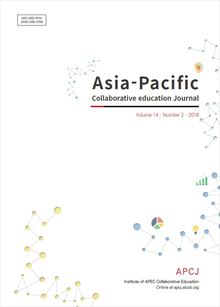간행물
Asia-Pacific Collaborative education Journal

- 발행기관 APEC국제교육협력원
- 자료유형 학술지
- 간기 반년간
- ISSN 2092-674X (Print)2092-6758 (Online)
- 수록기간 2004 ~ 2021
- 주제분류 사회과학 > 교육학 사회과학 분류의 다른 간행물
- 십진분류KDC 371DDC 379
권호리스트/논문검색
Volume 13 Number 1 (2017년 6월) 3건
Articles
1.
2017.06
구독 인증기관 무료, 개인회원 유료
This study investigated the relationship between class size and students’ participation on the academic performance of senior secondary school students in Nigeria. The population for this study comprised all the Senior Secondary school students in Mainland Local Government Area, Lagos State. The study adopted descriptive survey design and random sampling technique was used in arriving at the selection of two hundred and seventy (270) students and thirty (30) teachers among the population of senior secondary school students in Mainland Local Government Area in Lagos State, which formed the sample of this study. Specifically, students and teachers were randomly selected from six Senior Secondary schools in Mainland Local Government in Lagos State. Forty five (45) Senior Secondary school students and five (5) teachers were randomly sampled from each school. Two self- developed, structured and validated questionnaires (students’ questionnaire and teachers’ questionnaire) of 15 items for teachers’ questionnaire and 18 items for students’ questionnaire were used to collect information from the students and teachers after its validity and reliability were determined. The data collected were analyzed using mean, standard deviation, simple percentage while Pearson Product Moment Correlation Coefficient statistical tool was used for hypothesis testing at 0.05 levels of significance. The study revealed that: there is no significant relationship between class size and academic performance. There is significant difference between the students’ participation and their academics performance in secondary schools. There is no significance relationship between students’ perception of class size and the academic performance. There is no significance relationship between teachers’ perception of class size and the students’ academic performance.
4,800원
2.
2017.06
구독 인증기관 무료, 개인회원 유료
The purpose of this article is to understand the status of education informatization in the Philippines based on trainee reports of the APEC e-Learning Training Program from 2007 to 2013. The entire number of the Philippines trainees was 60. 15 K-Fishbone analyses, project areas of interest, and purpose for participation in the training course were included in the scope of analysis. Specifically, this paper highlighted a trend in changing ICT policies and initiatives in the Philippines through K-Fishbone analysis. There were 3 major trend shifts in education informatization: the initial period (2007~2008) showed a Reversed Trapezoidal type, which then changed to Diamond type (2009~2011) and recently to Left Side Stingray type (2012~2013). Through the initial stage (2007~2008), education policy, an education integration system, motivation and HW, SW were all been equally important. During the interim period (2009~2011), supply of HW, SW and training received greater attention, followed by the demand for education policy and an education integration system in recent years (2012~2013). Finally, the analysis results of the K-Fishbone analysis proved that they fit well with the policies and initiatives implemented by the Philippines Department of Education.
6,400원
3.
2017.06
구독 인증기관 무료, 개인회원 유료
In order to achieve its vision of an empowered society and a growing economy by December 2018, Zimbabwe, through its ZimAsset economic blueprint (Government of Zimbabwe, 2013) has planned to resuscitate and recapitalise the local industry. Like other nations, Zimbabwe’s industrialised economy is growing quickly and becoming one that embraces information communication technologies. Mathematics education and mathematical literacy feature high on the list of factors that can lead to growth in industry and a vibrant economy. This study therefore sought to explore the challenges and prospects of secondary mathematics education and industry synergies for socio-economic transformation in Zimbabwe. Data were generated from semi-structured interviews carried out in a previous study with 28 conveniently selected parents and with two parents in this current study. Open-ended questionnaires (questaviews) were given to ten purposively selected employers, two conveniently chosen science and mathematics education inspectors and ten randomly selected secondary school mathematics teachers in Gweru District, Zimbabwe. It was found that parents and employers strongly voiced the importance of mathematics in industry and for the country at large and offered suggestions on curriculum changes which they wished to be implemented. Employers were unhappy with the mathematics education system in Zimbabwe, which focused more on theory and less on practical work, attachment and fieldwork. It was concluded that shortages of material and financial resources, negative attitude of stakeholders and lack of a proper policy were the challenges that could hinder implementation of mathematics education-industry synergies. Some of the recommendations were that the Government should come up with a national policy on a mathematics curriculum that links classroom-gained knowledge with students’ careers because it will lead to the economic, scientific and technological development of the country. It was also recommended that employers work together with the teachers involved in students’ assessment and attachment and help students produce goods and artefacts for sale and the sustenance of their communities. This would be in line with constructivism and education with production principles.
4,600원

